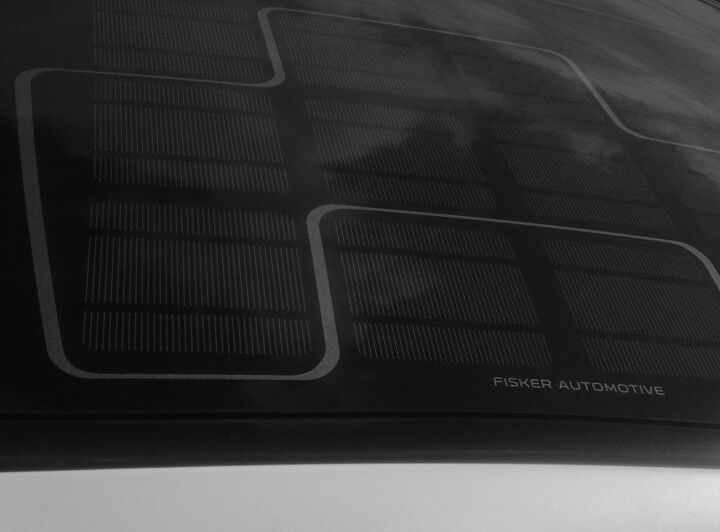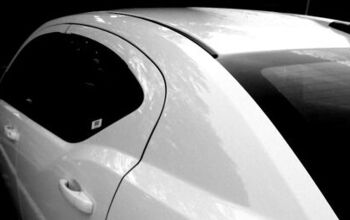Vellum Venom: 2012 Fisker Karma

One of my Transportation Design teachers insisted that cars were just like restaurants: success depends on proportion, proportion, proportion! And while the mere thought of his lectures makes me want to vomit in terror, the dude is right: cars need to be perfectly proportioned to prove a point. And my goodness, the Fisker Karma is just that. Put another way…
Pull up to any Cars and Coffee gathering in a Fisker and you only need to say this, “Karma’s a bitch, bitch.”
Why? Because you just won at Cars and Coffee, that’s why!
You know it when you see it: a car designed around the vision of a single person. In this case, the work of Mr. Henrik Fisker isn’t gonna leave anyone on the fence. More to the point: inside and out, this is a far more honest luxury sedan than the nauseatingly badge-engineered Aston Martin Rapide, and looks even sleeker.
Yes, the grille looks like a mustache, but it’s a very dashing look for a proper gent. The triangle theme on the lower valence is seen in the rear, and all cut lines flow from logical points: note how the hood lines accentuate the “hips” above the wheels, and how their turning point is the corner of each headlight. The only bummer is the black foam crash pads behind the bumper. You can’t see it from my camera phone, but they stick out like a sore thumb. Maybe those mustache grilles need a re-think.
The headlights also have a nice flow to them. The black plastic “waves” are what Mazda should have done with their Nagare design language: left in a hard to find but easy to appreciate location. And the LED’s elegant arrangement needs to be seen in person to really appreciate. The only question: did Visteon cut Fisker a break on pricing to have their name so prominently presented on the bi-xenon headlamps? One can hope.
Again: sorry for the lousy photos, but what you see from my phone is what I experienced. And did I ever see some amazing proportions! This is a classic luxury sedan with a long hood and short deck, a notion that’s been around since the day when custom coachbuilders still worked on cars with wood spoke wheels. When you think luxury, this is the proportioning that’s been mandatory since DAY ONE. Detroit would be wise to remember that.
The only stick in the mud is the oversized wheels. While I am sure everyone loves big-ass hoops for no reason, the Karma looks clownish with so much rim. The front wheels sit as high as the front door handles! The Karma is dying for a staggered wheel setup like a C5 Corvette. And yes, this 5300lb cruiser would ride better with less metal and more rubber sidewall.
With the monster rims out of the equation, you can see the Karma’s real beauty. The greenhouse is just so right. Kudos to Fisker for keeping true to the original concept. This is no small feat.
This is just stunning: every line just falls naturally into place, as if Mother Nature herself drew on the vellum. While I’d like less rim, the 22’s make more sense back here. And the oh-so-subtle door handles are a lost art: why can’t we have flush fitting door pulls again? Yes the Dodge Charger comes close…but no, it’s not close enough.
While the (metal) panel gaps are shockingly wide, the Karma is just so right. As I said when I first introduced TTAC to the Karma concept car, Fisker really shoulda named it the “Karma” Sutra. This body has so much tumblehome and is so deliciously curvaceous in every contour. This is actually a production car? Someone had the balls to green light a design this daring?
Once again, note how much tumblehome there is in the greenhouse, relative to the edges of the fenders. Wow. Even the cutlines for the decklid provide the right amount of curvaceous flair and firm angles to the package. And the triangles from the front are here on the back, in chrome. My only beef is with the oh-so-delicate taillights. This is a wide and low machine, a little more heft to the taillights toward the center would add some gravitas to the package. But just a little more, because it is almost perfect.
You might already know what this design feature accomplishes, but that’s not the point. When a designer needs to make a “feature” perform a certain duty, the gifted ones integrate it with the entire package. And here is the rear’s “feature” mimicking the front triangle theme. No doubt Fisker is a gifted designer, but kudos to him for seeing it through to production. This car is literally a concept car made for the streets.
Once more: this looks like a concept car. It could be vaporware. But it rides and drives…quite well I might add. But that’s not the point.
While I will not give any driving (or interior design) impressions on Vellum Venom, anyone who ever experienced the low-slung appeal of the C4 Corvette understands what makes the Karma so appealing. Both cars have similar hood bulges and fender flares from behind the wheel. And while the low-slung position means you see plenty of hood in your sightlines, who cares? This car is straight up impressive: all the appeal of the C4, with none of the ingress-egress difficulty.
Here’s another important design term to learn, so you can impress people with your mad skills: dash-to-axle ratio. The Karma is balanced at a proper ratio. Perhaps there will be a day when more automakers will get back to something “proper”. And perhaps Lincoln will make the 1977 Continental Mark V all over again. Yeah right.
Oh, and that exhaust pipe for the 2.0L Turbo mill is pretty cool too. Mercedes SLR aside, when was the last time you saw an exhaust pipe between the front wheel and the firewall? It’s been way too long, son…that’s what’s up.
Interesting note: the front passenger door handle has a conventional lock cylinder, but the driver’s door has nothing. While I appreciate the need for minimalism where a driver really needs it, there’s something not right about this. The driver always has the key, and he deserves a lock to go with it.
So what’s left to say? Fisker needed to prove itself to rich people. They also needed a vehicle that could capitalize on our need for alternative propulsion. My goodness, did they ever do both. Combining nearly 100 years of luxury coachbuilding elements, modern production capabilities and impressive attention to detail in every corner, the Fisker Karma is the reason why mammal skin is sacrificed in order to make vellum: it actually made production!
If you agree, do yourself a solid and seek one of these in person. Your eyeballs will not regret it.

More by Sajeev Mehta
Latest Car Reviews
Read moreLatest Product Reviews
Read moreRecent Comments
- Add Lightness I don't waste a lot of time watching nothing much happening by watching the YouTube 6 minute highlights.
- MrIcky from my rental fleet experience, id rather drive one of these than a camry.
- Add Lightness Protectionist fear competition under the guise of paranoia.
- Kjhkjlhkjhkljh kljhjkhjklhkjh But facebook, instagram, twitter, your cell phone, your chevy/ford/dodge, your debit card, your credit card selling your data to the SAME OVERSEAS DATABROKERS is ok.Meanwhile parler, telegram literally run on russian hardware is also ''ok''
- Redapple2 Dear lord ! That face. HARD NO.














































Comments
Join the conversation
I'm not sure there have been too many cars produced with the exhaust outlet in front of the driver, other than the McMerc SLR, for good reason!
@Sajeev: "Here’s another important design term to learn, so you can impress people with your mad skills: dash-to-axle ratio. The Karma is balanced at a proper ratio. Perhaps there will be a day..." Here's a term to learn, he sez, and then goes on to... NOT explain it. Wassup widdat, Sanjeev? You kidding with us, Steve?